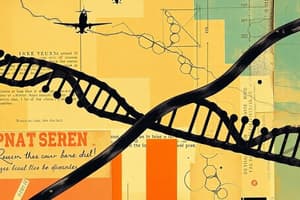Podcast
Questions and Answers
Which process describes the synthesis of mRNA from DNA?
Which process describes the synthesis of mRNA from DNA?
- Translation
- Transcription (correct)
- Replication
- Mutation
RNA is double-stranded like DNA.
RNA is double-stranded like DNA.
False (B)
What are the three types of mutations?
What are the three types of mutations?
Insertion, Deletion, Substitution
RNA carries the code for making proteins from the nucleus to the _______.
RNA carries the code for making proteins from the nucleus to the _______.
Match the following RNA characteristics with their descriptions:
Match the following RNA characteristics with their descriptions:
Which of the following is NOT a cause of mutations?
Which of the following is NOT a cause of mutations?
Which of the following statements accurately describes RNA?
Which of the following statements accurately describes RNA?
Mutations can be caused by exposure to ultraviolet light.
Mutations can be caused by exposure to ultraviolet light.
What is the process called that converts RNA into proteins?
What is the process called that converts RNA into proteins?
In DNA, thymine is replaced by ______ in RNA.
In DNA, thymine is replaced by ______ in RNA.
Match the type of mutation with its description:
Match the type of mutation with its description:
Which statement correctly describes the differences between DNA and RNA?
Which statement correctly describes the differences between DNA and RNA?
What type of sugar is found in RNA?
What type of sugar is found in RNA?
Mutations can only be caused by physical agents such as X-rays.
Mutations can only be caused by physical agents such as X-rays.
What is the primary function of RNA in protein synthesis?
What is the primary function of RNA in protein synthesis?
RNA is primarily found in the _______.
RNA is primarily found in the _______.
Match the following types of mutations with their descriptions:
Match the following types of mutations with their descriptions:
Which of the following processes occurs after transcription?
Which of the following processes occurs after transcription?
Flashcards
RNA
RNA
A type of nucleic acid that carries the code for making proteins from the nucleus to the cytoplasm.
Transcription
Transcription
The process of making messenger RNA (mRNA) from DNA.
Translation
Translation
The process of making a protein from mRNA.
Mutation
Mutation
Signup and view all the flashcards
Insertion Mutation
Insertion Mutation
Signup and view all the flashcards
Deletion Mutation
Deletion Mutation
Signup and view all the flashcards
Substitution Mutation
Substitution Mutation
Signup and view all the flashcards
Study Notes
RNA and DNA
- Ribonucleic Acid (RNA) is a nucleic acid carrying instructions for protein production from the nucleus to the cytoplasm.
- Transcription is the process of making mRNA from RNA.
- Translation is the process of making a protein from RNA.
- Mutations are changes in the nucleotide sequence of a gene.
- Proteins are created with RNA's assistance.
- RNA is a single-stranded molecule, unlike double-stranded DNA.
- RNA contains uracil (U) in place of thymine (T) found in DNA.
- mRNA is the first step in protein synthesis.
- There are three types of RNA: mRNA, tRNA, and rRNA. These RNA types work together to create proteins.
Causes of Mutations in RNA
- Exposure to X-rays
- Exposure to ultraviolet light
- Exposure to certain chemicals
- Exposure to radioactive materials
Types of RNA Mutations
- Insertion: adding one or more nitrogen bases to the DNA sequence.
- Deletion: removing one or more nitrogen bases from the DNA sequence.
- Substitution: replacing one nitrogen base with a different one.
Results of Mutations
- Mutations can alter proteins, potentially changing traits or causing genetic disorders.
- Not all mutations negatively impact the organism; some have no effect or even benefits.
DNA vs. RNA
- DNA:
- Double-stranded
- Deoxyribose sugar
- Contains the genetic material
- Found in the nucleus
- Contains Thymine (T)
- RNA:
- Single-stranded
- Ribose sugar
- Contains proteins
- Found in the cytoplasm
- Contains Uracil (U)
Studying That Suits You
Use AI to generate personalized quizzes and flashcards to suit your learning preferences.





